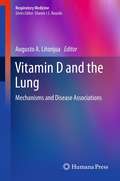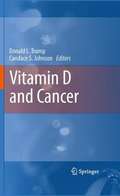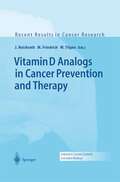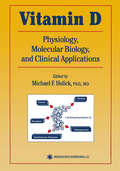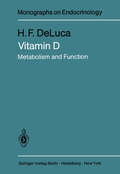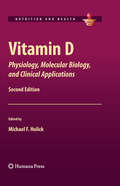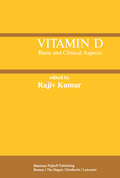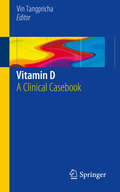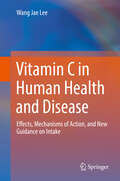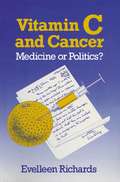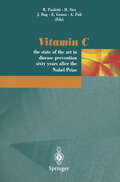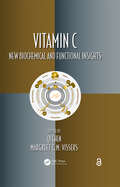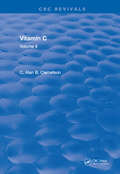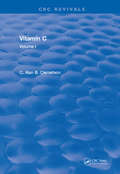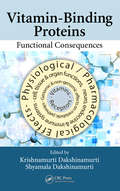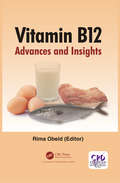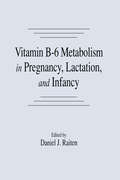- Table View
- List View
Vitamin D and the Lung: Mechanisms and Disease Associations (Respiratory Medicine #3)
by Augusto A. LitonjuaVitamin D deficiency is a worldwide problem and many associations with diseases are being discovered. Recently, there has been an interest in the role that vitamin D plays in the inception and progression of lung disease. Vitamin D and the Lung: Mechanisms and Disease Associations delivers a concise, evidence-based review of the evidence for a role of vitamin D in various lung disorders. Divided into three sections, the first section of the book delivers a review of how vitamin D deficiency emerged in human populations, and gives a perspective on how humans evolved to maximize the efficiency of production of vitamin D. The second section of the book reviews aspects of vitamin D mechanisms on different immune cells, lung tissue, and genetics that have potential impact on lung disease. The third section follows with chapters on associations of vitamin D with the risk for viral infections, asthma and allergies, chronic obstructive pulmonary disease, cystic fibrosis, tuberculosis, and finally, lung cancer with an emphasis on ongoing research and clinical issues and needs for future research in each field. Written by an international group of expert authors, Vitamin D and the Lung: Mechanisms and Disease Associations is an essential text for researchers in the respiratory field and practicing clinicians including internists, pulmonologists, and primary care personnel.
Vitamin D and Cancer
by Donald L. Trump Candace S. JohnsonSubstantial data indicate the broad importance of vitamin D-based signaling in normal human physiology and the broad effects of vitamin D deficiency. Vitamin D may play a role not only in the control of bone and mineral metabolism, but also appears to be involved in immune function, cardiovascular health, thrombosis and vasculogenesis and neuromuscular function. Considerable epidemiologic data demonstrate that low vitamin D serum levels occur very commonly in normal adult populations and that vitamin D deficiency is associated with an enhanced risk of cancer death from lung, prostate, head & neck, colorectal and other gastrointestinal cancers. In addition, preclinical data provide evidence that calcitriol and other active analogues of calcitriol have anti-proliferative, pro-differentiative, pro-apoptotic and anti-angiogenic activity in numerous in-vitro and in-vivo models. It is quite clear that, while it requires high exposure to calcitriol to induce these effects, such exposure can be readily achieved when high dose intermittent therapy is given.
Vitamin D Analogs in Cancer Prevention and Therapy (Recent Results in Cancer Research #164)
by J. Reichrath, M. FriedrichA comprehensive, highly readable overview of the topics discussed at the First International Symposium on "Vitamin D Analogs in Cancer Prevention and Therapy" held in Homburg/Saar, Germany in May 2002. Leading researchers discuss our present knowledge of the vitamin D system in cancer. Topics range from the newest findings in molecular biology, epidemiology, synthesis and metabolism of vitamin D to new concepts for the use of vitamin D analogs in cancer prophylaxis and treatment. The book provides essential up-to-date information for every researcher or clinician interested in the biology of vitamin D or cancer.
Vitamin D: Physiology, Molecular Biology, and Clinical Applications (Nutrition and Health)
by Adrianne BendichThe Nutrition and Health series of books has as an overriding mission to provide health professionals with texts that are considered essential because each includes: a synthesis of the state of the science; timely, in-depth reviews by the leading researchers in their respective fields; extensive, up-to-date fully annotated reference lists; a detailed index; relevant tables and figures; identification of paradigm shifts and the consequences; of information between chapters, but targeted, inter-chapter refer virtually no overlap rals, suggestions of areas for future research; and balanced, data-driven answers to patient questions that are based on the totality of evidence rather than the findings of any single study. The series volumes are not the outcome of a symposium. Rather, each editor has the potential to examine a chosen area with a broad perspective, both in subject matter as well as in the choice of chapter authors. The international perspective, especially with regard to public health initiatives, is emphasized where appropriate. The editors, whose training is both research and practice oriented, have the opportunity to develop a primary objective for their book, define the scope and focus, and then invite the leading authori ties from around the world to be part of their initiative. The authors are encouraged to provide an overview of the field, discuss their own research, and relate the research de findings to potential human health consequences.
Vitamin D: Metabolism and Function (Monographs on Endocrinology #13)
by H.F. DeLucaBecause diseases of the bone are often less acute and less lifethreatening than dis eases of the circulatory system, gastrointestinal tract, kidney, liver, and the nervous system, they have received a disproportionately smaller amount of attention in the medical world. With the average increasing life span of man as a result of improve ments in modern medicine, espe~ially in the pediatric field, the seriousness of many metabolic bone diseases has indeed become more obvious. In addition, other improvements in medicine, such as hemodialysis for the preservation of renal failure patients, have permitted the development of other consequences of diseased kidneys, one of which is the appearance of renal osteodystrophy. Finally, the appearance of several genetic disorders in the area of metabolic bone disease has been underscored by the solution of other pediatric diseas~s of much more serious consequences. These emerging problems all suggest that much remains to be learned concerning the sys temic control of bone, both as a structural organ and as a reservoir for the important elements of calcium and phosphorus so essential for the support of life in complex multicellular organisms of which man is the most important. As will be demonstrated in the historical portion of this manuscript, the existence of the three most important humoral factors regulating bone metabolism and func tion are now known.
Vitamin D: Physiology, Molecular Biology, and Clinical Applications (Nutrition and Health)
by Michael F. HolickIn Vitamin D: Physiology, Molecular Biology, and Clinical Applications, Second Edition, leading researchers provide a comprehensive, highly readable overview of the biological functions and clinical applications of vitamin D and its metabolites. Topics range from the most recent recommendations for vitamin D intake to new approaches for the treatment and prevention of vitamin D deficiency and the development of active vitamin D drugs to treat psoriasis and cancer. The book demonstrates the significant role that vitamin D has in maintaining good bone health and the prevention of osteoporosis, an important health problem for adults over the age of fifty. In addition, it authoritatively reviews the relationship between sunlight exposure, vitamin D, and increased risk of colon and breast cancer; how vitamin D is made in the skin; and the sequence of events that leads to its activation by the kidney. Also examined are the biological functions of 1,25-dihydrovitamin D3 on the intestine and bone, as well as other tissues, such as skin, the immune system, prostate, and breast, and vitamin D's molecular mechanism of action on the cell membrane and nucleus. The first edition of Vitamin D: Physiology, Molecular Biology and Clinical Applications was the benchmark in the field when published in 1999. This new and expanded volume continues to include extensive, in-depth chapters covering the most important aspects of the complex interactions between vitamin D and other dietary components, the ongoing debate concerning the best indicator of optimal vitamin D status and its nutrient requirements, and the impact of less than optimal status on disease risk. Vitamin D: Physiology, Molecular Biology, and Clinical Applications, Second Edition is designed and organized not only to be an up-to-date review on the subject, but also to provide medical students, graduate students, health care professionals and even the lay public with a reference source for the most up-to-date information about the vitamin D deficiency pandemic and its clinical implications for health and disease.
Vitamin D: Basic and Clinical Aspects
by RajivKumarMany advances in vitamin D physiology and biochemistry have been made in recent years. Vitamin D metabolites and analogs have found increasing application in clinical medicine. The purpose of this text is to review what is known about vitamin D physiology and draw attention to areas of vitamin D research that have changed within the last 2-3 years. Additionally, information concerning clinical aspects of vitamin D is also presented. More than 40 scientists have generously contributed chapters to this text; I thank them for their efforts. As might be expected, not everyone has the same point of view. Finally, I would like to acknowledge the secretarial and editorial efforts of Mrs. Cheryl Collins without whom this book would not have been completed. CONTRIBUTORS ETSUKO ABE, Department of Biochemistry, School of Dentistry, Showa University, 1-5-8, Hatanodai, Shinagawa-KU, Tokyo 142, Japan DAVID J. BAYLINK, Department of Medicine, Loma Linda University, Loma Linda, CA, and Pettis Veterans Hospital, 11201 Benton Street, Loma Linda, CA, 92357, USA NORMAN H. BELL, Department of Medicine, Medical University of South Carolina and Veterans Administration Medical Center, 109 Bee Street, Charleston, SC, 29403, USA WARNER M. BURCH, Jr. , Departments of Medicine and Physiology, Duke Univer sity Medical Center, Durham, NC, 27710, USA DAVID V. COHN, ICCRH, Inc. , 1238 Wyncrest Court, Arden Hills, MN, 55112, USA ROBERT A. CORRADINO, Department of Physiology, New York State College of Veterinary Medicine, Cornell University, 720 VRT, Ithaca, NY, 14853, USA HECTOR F.
Vitamin D: A Clinical Casebook
by Vin TangprichaComprised exclusively of clinical cases covering disorders of vitamin D and its clinical management, this concise, practical casebook will provide clinicians in endocrinology with the best real-world strategies to properly diagnose and treat the various forms of the condition they may encounter. Each chapter is a case that opens with a unique clinical presentation, followed by a description of the diagnosis, assessment and management techniques used to treat it, as well as the case outcome and clinical pearls and pitfalls. Cases included illustrate different causes of deficiency as well as management strategies, including deficiency in healthy patients and infants, in eating disorders and gastric bypass, surgical and chronic hypoparathyroidism, and chronic kidney disease, among others. Pragmatic and reader-friendly, Vitamin D: A Clinical Casebook will be an excellent resource for clinical endocrinologists, nutritionists, and family and emergency medicine physicians alike.
Vitamin C in Human Health and Disease: Effects, Mechanisms of Action, and New Guidance on Intake
by Wang Jae LeeThis book presents the scientific evidence for the role of vitamin C in health and disease and offers new guidance on vitamin C intake in humans. The importance of vitamin C in preventing cancer and cardiovascular disease, its relevance to aging and stress, and its impacts on each of the human body systems are thoroughly assessed on the basis of the author’s extensive research and his deep understanding, as an anatomy professor, of the body as a whole. Findings published in the international scientific literature are fully taken into account, and due consideration is also given to empirical evidence, bearing in mind that mechanisms of action cannot always be precisely defined in the absence of human experiments. Beyond providing an up-to-date scientific perspective on the effects of vitamin C, the author hopes to promote human health worldwide by encouraging proper use of the vitamin. To this end, recommendations are made on the amount of vitamin C that should be taken daily and on the best way to take it. The book will be of interest to researchers, clinicians, and all others who wish to learn more about this vitamin and its significance.
Vitamin C and Cancer: Medicine or Politics?
by Evelleen RichardsA study of the development and rejection of vitamin C as a treatment for cancer, this text also explores the evaluation process of such a contentious treatment. Based on social, economic and financial considerations, it sees these decisions as political rather than objective assessments.
Vitamin C: The state of the art in disease prevention sixty years after the Nobel Prize
by AndreaPoli EnzoGrossi JoachimBug HelmutSies RodolfoPaolettiVitamin C, or ascorbic acid, has a long and multifaceted scientific history. In 1937, the Nobel Prize for Physiology and Medicine was awarded to Albert Szent-Gyorgyi'in recognition of his discoveries concerning the biological oxida tion processes with special reference to vitamin C', and the Nobel Prize for Chemistry was shared by Sir Norman W. Haworth, who was the first to synthesize the vitamin. Vitamin C is a potent antioxidant, and this action represented the theoretical basis for various lines of investigation on this molecule in which the potential role of ascorbic acid in the prevention and treatment of a series of dis eases, whose pathogenesis is linked to an excess of free radicals such as athero sclerosis and cancer, have been examined. These data have been analyzed in detail by experts in biochemistry, epidemi ology, and preventive and clinical medicine in the International Symposium Vitamin C, the state of the art in disease prevention sixty years after the Nobel Prize, held in Monte Carlo from October 31 to November 1, 1997, under the aus pices and the scientific endorsement of the Nutrition Foundation of Italy and with the financial support of Bracco SpA and Merck.
Vitamin C: New Biochemical and Functional Insights (Oxidative Stress and Disease #1)
by Qi Chen Margreet C.M. VissersVitamin C holds a unique place in scientific and cultural history. In this book, a group of leading scientific researchers describe new insights into the myriad ways vitamin C is employed during normal physiological functioning. In addition, the text provides an extensive overview of the following: the rationale for utilizing vitamin C in the clinic, updates on recent uses of vitamin C in cancer treatment through high-dose intravenous therapies, the role vitamin C plays in the treatment of sepsis and infectious disease, management of the ways vitamin C can improve stem cell differentiation, as well as vitamin C use in other important health situations. Features Includes chapters from a team of leading international scholars Reviews the history and recent research on the functions, benefits, and uses of vitamin C Focuses special attention on the way vitamin C can be used in the treatment of cancers Discusses how vitamin C can be employed against infectious disease
Vitamin C: New Biochemical and Functional Insights (Oxidative Stress and Disease #1)
by Qi Chen Margreet C. M. VissersVitamin C holds a unique place in scientific and cultural history. In this book, a group of leading scientific researchers describe new insights into the myriad ways vitamin C is employed during normal physiological functioning. In addition, the text provides an extensive overview of the following: the rationale for utilizing vitamin C in the clinic, updates on recent uses of vitamin C in cancer treatment through high-dose intravenous therapies, the role vitamin C plays in the treatment of sepsis and infectious disease, management of the ways vitamin C can improve stem cell differentiation, as well as vitamin C use in other important health situations. Features Includes chapters from a team of leading international scholars Reviews the history and recent research on the functions, benefits, and uses of vitamin C Focuses special attention on the way vitamin C can be used in the treatment of cancers Discusses how vitamin C can be employed against infectious disease
Vitamin C: Volume III
by Alan B. ClemetsonThe factors affecting blood vitamin C levels are described in detail in this series. Many factors such as aging, smoking, infection, trauma, surgery, hemolysis, hormone administration, heavy metals, pregnancy, alcohol, ionizing radiation and several medicines have been found to cause a disturbance of ascorbic acid metabolism and to reduce blood vitamin C levels. Indeed, abnormalities of ascorbic acid metabolism, due to factors such as smoking, occur much more frequently than does dietary vitamin C deficiency today.It is now known that low blood vitamin C levels are associated with histaminemia (high blood histamine levels), and also that ascorbate-responsive histaminemia is common in apparently healthy people. High blood histamine levels are believed to cause small hemorrhages within the inner walls of the blood vessels and these may lead to the deposition of cholesterol, as an aberrant form of wound healing. Ascorbic acid not only reduces blood histamine levels, but also aids the conversion of cholesterol to bile acids in the liver. The clinical pathological and chemical changes observed in ascorbic acid deficiency are discussed in detail. Several diseases and disorders associated with low blood vitamin C levels are also described. Possible toxic effects resulting from the oxidation of ascorbic acid are noted, and reasons for the use of D-catechin or other chelating fiber to prevent or minimize the release of ascorbate-free radical are detailed. An excellent reference for physicians, nutritionists and other scientists
Vitamin C: Volume III
by Alan B. ClemetsonThe factors affecting blood vitamin C levels are described in detail in this series. Many factors such as aging, smoking, infection, trauma, surgery, hemolysis, hormone administration, heavy metals, pregnancy, alcohol, ionizing radiation and several medicines have been found to cause a disturbance of ascorbic acid metabolism and to reduce blood vitamin C levels. Indeed, abnormalities of ascorbic acid metabolism, due to factors such as smoking, occur much more frequently than does dietary vitamin C deficiency today.It is now known that low blood vitamin C levels are associated with histaminemia (high blood histamine levels), and also that ascorbate-responsive histaminemia is common in apparently healthy people. High blood histamine levels are believed to cause small hemorrhages within the inner walls of the blood vessels and these may lead to the deposition of cholesterol, as an aberrant form of wound healing. Ascorbic acid not only reduces blood histamine levels, but also aids the conversion of cholesterol to bile acids in the liver. The clinical pathological and chemical changes observed in ascorbic acid deficiency are discussed in detail. Several diseases and disorders associated with low blood vitamin C levels are also described. Possible toxic effects resulting from the oxidation of ascorbic acid are noted, and reasons for the use of D-catechin or other chelating fiber to prevent or minimize the release of ascorbate-free radical are detailed. An excellent reference for physicians, nutritionists and other scientists
Vitamin C: Volume II
by Alan B. ClemetsonThe factors affecting blood vitamin C levels are described in detail in this series. Many factors such as aging, smoking, infection, trauma, surgery, hemolysis, hormone administration, heavy metals, pregnancy, alcohol, ionizing radiation and several medicines have been found to cause a disturbance of ascorbic acid metabolism and to reduce blood vitamin C levels. Indeed, abnormalities of ascorbic acid metabolism, due to factors such as smoking, occur much more frequently than does dietary vitamin C deficiency today.It is now known that low blood vitamin C levels are associated with histaminemia (high blood histamine levels), and also that ascorbate-responsive histaminemia is common in apparently healthy people. High blood histamine levels are believed to cause small hemorrhages within the inner walls of the blood vessels and these may lead to the deposition of cholesterol, as an aberrant form of wound healing. Ascorbic acid not only reduces blood histamine levels, but also aids the conversion of cholesterol to bile acids in the liver. The clinical pathological and chemical changes observed in ascorbic acid deficiency are discussed in detail. Several diseases and disorders associated with low blood vitamin C levels are also described. Possible toxic effects resulting from the oxidation of ascorbic acid are noted, and reasons for the use of D-catechin or other chelating fiber to prevent or minimize the release of ascorbate-free radical are detailed. An excellent reference for physicians, nutritionists and other scientists
Vitamin C: Volume I
by Alan B. ClemetsonThe factors affecting blood vitamin C levels are described in detail in this series. Many factors such as aging, smoking, infection, trauma, surgery, hemolysis, hormone administration, heavy metals, pregnancy, alcohol, ionizing radiation and several medicines have been found to cause a disturbance of ascorbic acid metabolism and to reduce blood vitamin C levels. Indeed, abnormalities of ascorbic acid metabolism, due to factors such as smoking, occur much more frequently than does dietary vitamin C deficiency today.It is now known that low blood vitamin C levels are associated with histaminemia (high blood histamine levels), and also that ascorbate-responsive histaminemia is common in apparently healthy people. High blood histamine levels are believed to cause small hemorrhages within the inner walls of the blood vessels and these may lead to the deposition of cholesterol, as an aberrant form of wound healing. Ascorbic acid not only reduces blood histamine levels, but also aids the conversion of cholesterol to bile acids in the liver. The clinical pathological and chemical changes observed in ascorbic acid deficiency are discussed in detail. Several diseases and disorders associated with low blood vitamin C levels are also described. Possible toxic effects resulting from the oxidation of ascorbic acid are noted, and reasons for the use of D-catechin or other chelating fiber to prevent or minimize the release of ascorbate-free radical are detailed. An excellent reference for physicians, nutritionists and other scientists
Vitamin C: Volume I
by Alan B. ClemetsonThe factors affecting blood vitamin C levels are described in detail in this series. Many factors such as aging, smoking, infection, trauma, surgery, hemolysis, hormone administration, heavy metals, pregnancy, alcohol, ionizing radiation and several medicines have been found to cause a disturbance of ascorbic acid metabolism and to reduce blood vitamin C levels. Indeed, abnormalities of ascorbic acid metabolism, due to factors such as smoking, occur much more frequently than does dietary vitamin C deficiency today.It is now known that low blood vitamin C levels are associated with histaminemia (high blood histamine levels), and also that ascorbate-responsive histaminemia is common in apparently healthy people. High blood histamine levels are believed to cause small hemorrhages within the inner walls of the blood vessels and these may lead to the deposition of cholesterol, as an aberrant form of wound healing. Ascorbic acid not only reduces blood histamine levels, but also aids the conversion of cholesterol to bile acids in the liver. The clinical pathological and chemical changes observed in ascorbic acid deficiency are discussed in detail. Several diseases and disorders associated with low blood vitamin C levels are also described. Possible toxic effects resulting from the oxidation of ascorbic acid are noted, and reasons for the use of D-catechin or other chelating fiber to prevent or minimize the release of ascorbate-free radical are detailed. An excellent reference for physicians, nutritionists and other scientists
Vitamin C: Volume II
by Alan B. ClemetsonThe factors affecting blood vitamin C levels are described in detail in this series. Many factors such as aging, smoking, infection, trauma, surgery, hemolysis, hormone administration, heavy metals, pregnancy, alcohol, ionizing radiation and several medicines have been found to cause a disturbance of ascorbic acid metabolism and to reduce blood vitamin C levels. Indeed, abnormalities of ascorbic acid metabolism, due to factors such as smoking, occur much more frequently than does dietary vitamin C deficiency today.It is now known that low blood vitamin C levels are associated with histaminemia (high blood histamine levels), and also that ascorbate-responsive histaminemia is common in apparently healthy people. High blood histamine levels are believed to cause small hemorrhages within the inner walls of the blood vessels and these may lead to the deposition of cholesterol, as an aberrant form of wound healing. Ascorbic acid not only reduces blood histamine levels, but also aids the conversion of cholesterol to bile acids in the liver. The clinical pathological and chemical changes observed in ascorbic acid deficiency are discussed in detail. Several diseases and disorders associated with low blood vitamin C levels are also described. Possible toxic effects resulting from the oxidation of ascorbic acid are noted, and reasons for the use of D-catechin or other chelating fiber to prevent or minimize the release of ascorbate-free radical are detailed. An excellent reference for physicians, nutritionists and other scientists
Vitamin-Binding Proteins: Functional Consequences
by Krishnamurti Dakshinamurti Shyamala DakshinamurtiDiverse in chemical nature, water soluble and lipid soluble vitamins are essential micronutrients that react with specific protein entities and are transported to sites for participation in intracellular events, both at the genomic and non-genomic levels. Thus, metabolic pathways and intracellular signaling are influenced by vitamins or their deriv
Vitamin-B12-Stoffwechsel von Granulozyten: Einbau und subzelluläre Verteilung von Vitamin B12 in Granulozyten und CML-Granulozyten (Forschungsberichte des Landes Nordrhein-Westfalen)
by Rudolf PfeifferVitamin B12: Advances and Insights
by Rima ObeidCobalamin (vitamin B12) was discovered in the first half of the 20th century. Vast amount of information on the role of the vitamins in human health and disease became available. Cobalamin science was, however, based on theoretical concepts that have been accepted without further proof of facts and hypotheses. Recently, the breath-taking pace of development in research technologies has changed our understanding for the role of nutrients and the complex interaction between diet, environment and diseases. Conditions like aging, diet and drugs increase the risk of developing cobalamin deficiency, probably because of diminished ability to liberate, absorb or distribute the food-derived vitamin. From a basic science point of view, understanding of the transport and function of the vitamin, may pave the road for using this system for drug delivery. This book represents up-to-date literature on the discoveries and developments in the field of cobalamin. It includes multifaceted aspects of the vitamin in health and disease conditions. The book has been written by leading scientists who have significant contributions in this field and represents therefore, a timely unique encyclopaedia on cobalamin.
Vitamin B12: Advances and Insights
by Rima ObeidCobalamin (vitamin B12) was discovered in the first half of the 20th century. Vast amount of information on the role of the vitamins in human health and disease became available. Cobalamin science was, however, based on theoretical concepts that have been accepted without further proof of facts and hypotheses. Recently, the breath-taking pace of development in research technologies has changed our understanding for the role of nutrients and the complex interaction between diet, environment and diseases. Conditions like aging, diet and drugs increase the risk of developing cobalamin deficiency, probably because of diminished ability to liberate, absorb or distribute the food-derived vitamin. From a basic science point of view, understanding of the transport and function of the vitamin, may pave the road for using this system for drug delivery. This book represents up-to-date literature on the discoveries and developments in the field of cobalamin. It includes multifaceted aspects of the vitamin in health and disease conditions. The book has been written by leading scientists who have significant contributions in this field and represents therefore, a timely unique encyclopaedia on cobalamin.
Vitamin B-6 Metabolism in Pregnancy, Lactation, and Infancy
by Daniel J. RaitenThis book provides a comprehensive review of our knowledge of vitamin B-6 requirements and metabolism throughout pregnancy and lactation. It concentrates on two primary points: adequacy of available methodologies and a presentation of the extant knowledge on vitamin B-6 metabolism and requirements in pregnancy, infancy, lactation, and in women of childbearing age. Many of the chapters offer new perspectives on how decisions have been and are being made with regard to the establishment of dietary recommendations about vitamin B-6 and the adequacy of research to support these decisions.
Vitamin B-6 Metabolism in Pregnancy, Lactation, and Infancy
by Daniel J. RaitenThis book provides a comprehensive review of our knowledge of vitamin B-6 requirements and metabolism throughout pregnancy and lactation. It concentrates on two primary points: adequacy of available methodologies and a presentation of the extant knowledge on vitamin B-6 metabolism and requirements in pregnancy, infancy, lactation, and in women of childbearing age. Many of the chapters offer new perspectives on how decisions have been and are being made with regard to the establishment of dietary recommendations about vitamin B-6 and the adequacy of research to support these decisions.
